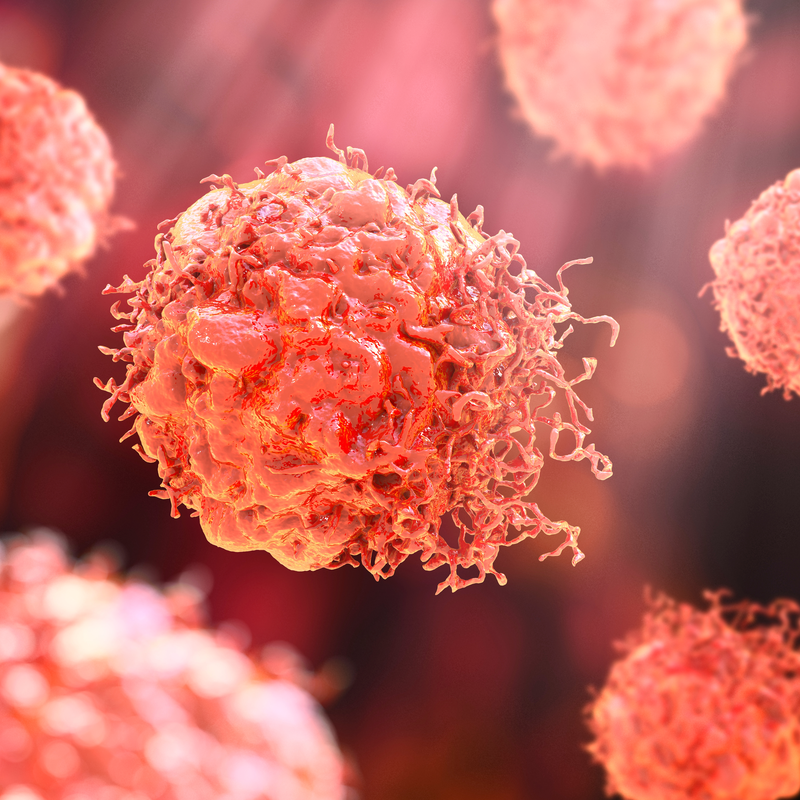
What is a myxoid epithelioid sarcoma?
A epithelioid sarcoma (ES) is a rare, distinct type of sarcoma that has a specific morphology and immunophenotype (sum of genetically determined surface features of a cell). The disease originates in soft tissue and accounts for less than one per cent of all malignant (malignant) soft tissue sarcomas. A myxoid epithelioid sarcoma occurs more frequently than average in young adults, but can generally develop at any stage of life . The tumour appears more often in men than in women and was first defined by Enzinger in 1970.
What causes myxoid epithelioid sarcoma to form?
Between 80 to 90 percent of all cases of the disease are due to the inactivation, or loss of function of the tumour suppressor gene SMARCB1 . This tumour suppressor, which is located on chromosome 22 at gene locus 22q11.2, can be identified as an essential factor for the pathogenesis and progression of the disease.
Where does myxoid epithelioid sarcoma prefer to occur?
A myxoid epithelioid sarcoma develops mainly on the distal extremities, such as the fingers, the hands, the forearm or the feet . Myxoid epithelioid sarcoma is less common on the proximal extremities and even less common on the pelvis, pensi, vulva or back.
What are the symptoms of myxoid epithelioid sarcoma?
Especially in the early stages, myxoid epithelioid sarcoma is asymptomatic. If the tumour appears, it is visible as a painless (indolent) swelling or induration or a series of swellings. As the tumour grows in size, it can displace neighbouring structures and possibly lead to restricted movement. Unwanted weight loss may also occur due to the disease .
In the following cases, there is an urgent suspicion of a myxoid epithelioid sarcoma, which should definitely be clarified by a doctor:
- the appearance of one or more lumps that are larger than 5 centimetres,
- the appearance of sudden new lumps without any visible reason,
- the appearance of lumps that are located in deeper tissue layers,
- Nodules or swellings that grow quickly,
- the occurrence of deeper and/or extensive bruising, so-called haematoma.
How is myxoid epithelioid sarcoma diagnosed?
Since myxoid epithelioid sarcoma grows rather slowly, the disease is usually misinterpreted as a non-neoplastic lesion and diagnosed even later. Therefore, in most cases, the tumour has already reached an advanced stage when it is first diagnosed, and it may have already metastasised . In order to make a definite diagnosis, it is always essential to take a tissue sample (biopsy) .
How is a myxoid epithelioid sarcoma treated?
The first choice of treatment for a myxoid epithelioid sarcoma is usually surgical removal of the tumour. Since the tumour usually grows in a fan-shaped and radical manner, the surgical treatment should therefore also be radical. Even if a clinical lymph node infestation has not yielded a result, a biopsy of the regional lymph nodes should still be performed. After successful tumour removal, external or local radiotherapy can also be considered. If the tumour has already metastasised, chemotherapy should be administered. Particularly when removing large tumours, plastic surgery measures can mask the effects of the operation.
What is the aftercare for myxoid epithelioid sarcoma?
After treatment, the patient should continue to attend regular follow-up examinations at in order to diagnose the recurrence of the tumour (recurrence) or metastasis at an early stage if necessary. In most cases of the disease, both a recurrence and a metastasis manifest themselves in the first two to three years after primary therapy. It can also happen that both phenomena still appear in up to ten years after primary treatment. Within the follow-up examinations, close attention should therefore be paid to the search for metastases. In general, it is advisable that follow-up examinations, but also the treatment of a myxoid epithelioid sarcoma, are always carried out by sarcoma experts . Multidisciplinary sarcoma centres could be the ideal contact for this. If you are unsure in some cases, it may also be advisable to seek a second opinion.
What is the prognosis for myxoid epithelioid sarcoma?
A myxoid epithelioid sarcoma tends to form again (recurrence) in 38 percent of all cases, even after successful treatment. Also, in 20 to 40 percent of all cases, lymph node metastases can occur. In worse cases, distant metastases may also form , for example in the lungs, kidneys or brain . Because of this, the general prospects of recovery from myxoid epithelioid sarcoma are rather modest. The 10-year survival rate is 50 percent, although the risk of death increases considerably in the case of metastasis. In order to make a meaningful prognosis of the disease, the size of the tumour is also important . If the tumour is over 5 centimetres in size, the probability of survival decreases significantly.
What is life like with myxoid epithelioid sarcoma?
Patients are advised to take care of a healthy lifestyle in order to alleviate the consequences of the therapy, but also to be strengthened for a possible upcoming therapy. Since the diagnosis of cancer in general can prove to be very psychologically stressful, those affected should seek a sympathetic ear in self-help groups from other people who have experienced similar things. One contact person you can turn to is the German Sarcoma Foundation, for example. In order not to lose heart , survival statistics should also not be used excessively, especially since they depend on a number of disease factors anyway.
